Perched on Red Hill in Lhasa, Potala Palace is not just a landmark but a treasure of Tibetan culture, recognized as a 5A tourist attraction. Since 1994, it has proudly been listed on the UNESCO World Heritage Site list. The palace’s name, derived from the Sanskrit ‘Potalaka,’ refers to the mythical abode of Avalokiteshvara, embodying peace and sanctity.
For Tibetans, Potala Palace is as sacred as Mount Putuo, where Avalokiteshvara is believed to reside. This deep reverence has earned it the title “The Second Druzin, (རི་བོ་གྲུ་འཛིན་) signifying its importance as a Buddhist holy site. Constructed in the 7th century, the palace has a history spanning over 1300 years, making it the most grandiose and well-preserved ancient palace complex in Tibet.
The Symbol for the Rise of the Tubo Dynasty: Potala Palace
The foundation of Potala Palace (རྩེ་པོ་ཏ་ལ།) is intertwined with the rise of the Tubo dynasty in the early 7th century. Under the leadership of Songtsen Gampo, who ruled from 629 to 650, Tibet was unified through a series of conquests, establishing a powerful empire. In 633, with the move of the capital to Lhasa, Songtsen Gampo forged a significant alliance with the Tang dynasty, marking a new era of prosperity and cultural exchange. Potala Palace stands as a testament to Tibet’s rich history and spiritual depth. Beyond its architectural magnificence, the palace encapsulates the heart of Tibetan Buddhism and its centuries-old traditions. It’s a place where history and spirituality meet, offering visitors a glimpse into the soul of Tibet.
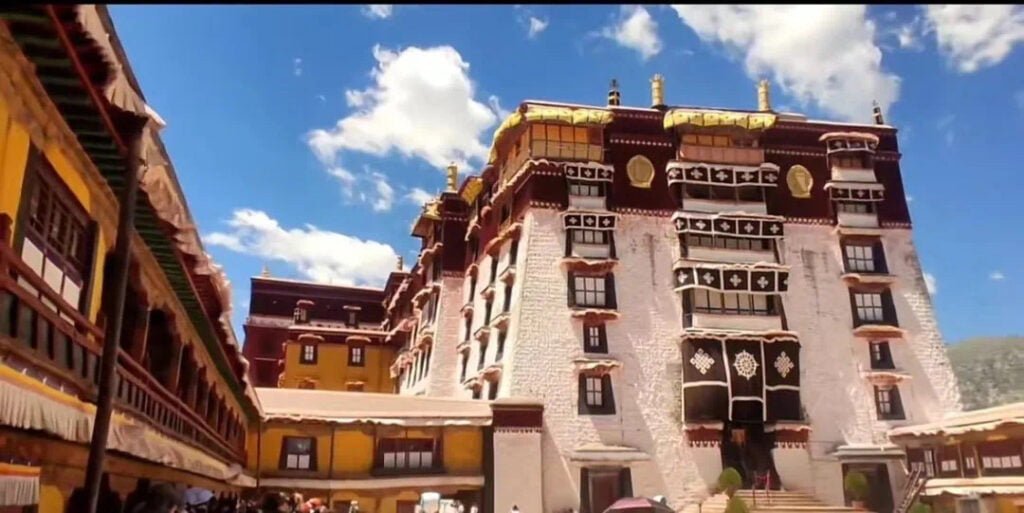
Potala Palace: A Testament to Love and Resilience
In the year 641, Princess Wencheng made a historic journey from the Tang dynasty to Tibet, marrying Songtsen Gampo and marking a significant chapter in Sino-Tibetan relations. To honor his brides, Songtsen Gampo constructed a magnificent city with walls stretching 500 meters on each side. On Red Hill, he built 999 rooms, and with the red upper chambers, the total came to a grand thousand. This palace, adorned with treasures and resonating with the sound of bells, was majestic and splendid. Recognizing its sanctity, Buddhists later likened it to Mount Putuo, hence naming it “Potala Palace,” which is a transliteration of the sacred mountain’s name.
The original Potala Palace, built during Songtsen Gampo’s era, faced several disasters over the centuries. First, it was struck by lightning and caught fire during Trisong Detsen‘s reign (755–797). Then, it suffered further damage in the turmoil that marked the end of the Tubo dynasty. Only the “Chogyal Drubphug” (King’s Meditation Cave) and “Pabala Khang” (Pabala Hall) survived from that time.
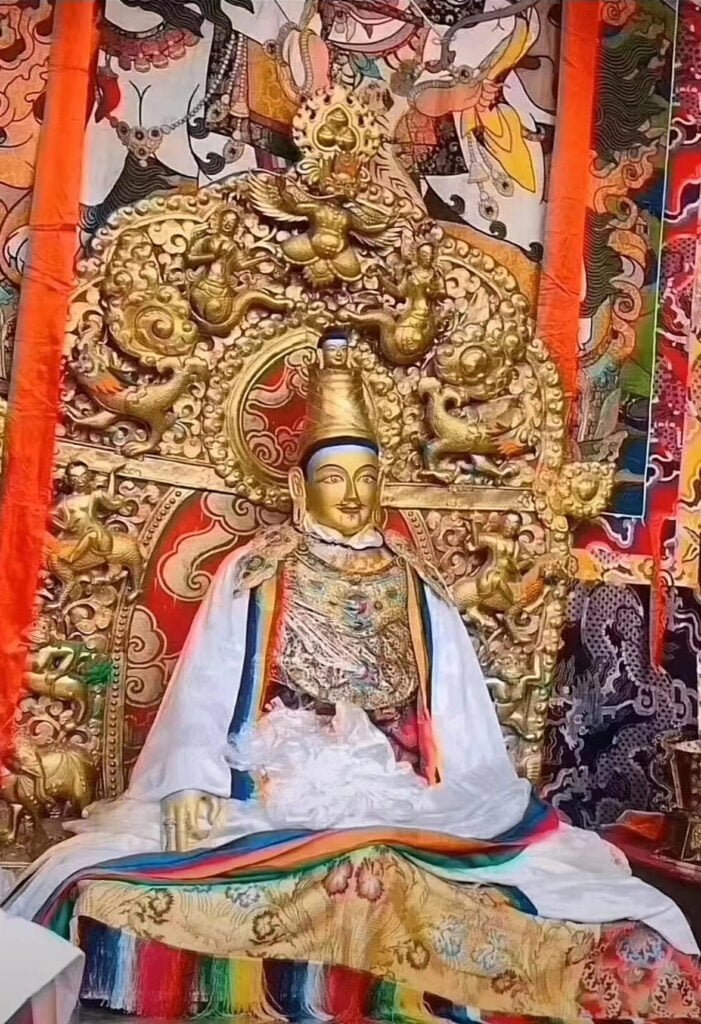
The Rebirth of Potala Palace
The Potala Palace standing today was reconstructed on the ruins of the original structure in the 17th century. In 1642, with the support of Güshi Khan, the Great Fifth Dalai Lama, Lobsang Gyatso, established the Ganden Phodrang government. This marked a new era, with Lhasa reclaiming its status as the political heart of Tibet.
Potala Palace’s history is not just a tale of architectural marvels; it’s a story of love, diplomacy, and resilience. From its origins to celebrate a royal marriage to its rebirth as a symbol of Tibetan spirit, the palace embodies the enduring strength and cultural richness of Tibet. Visiting Potala Palace offers a glimpse into the past, where every stone tells a story of unity, faith, and indomitable will.
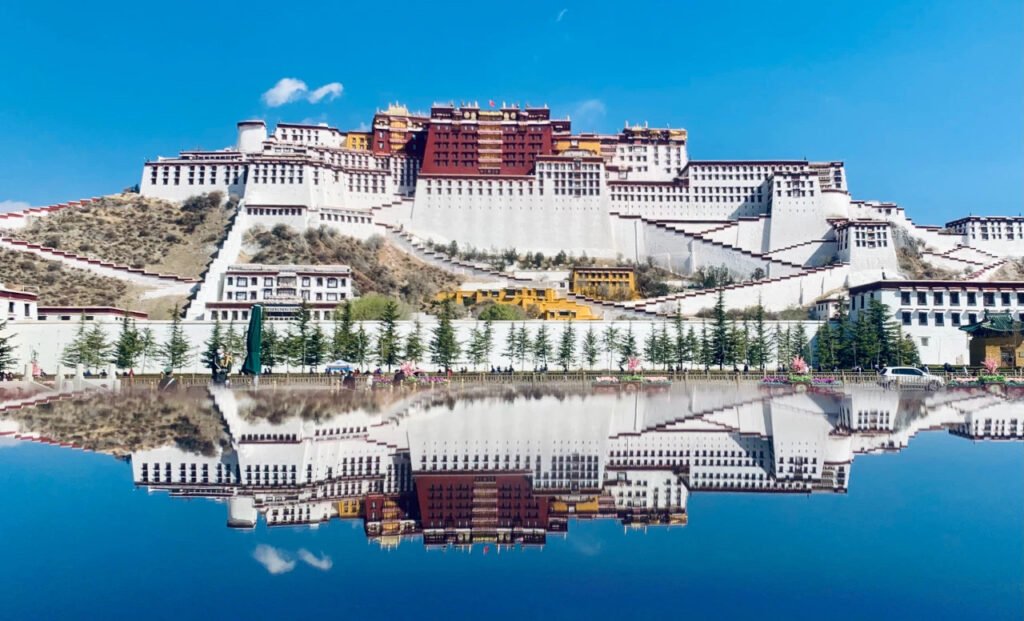
The Reconstruction of Potala Palace Under the Fifth Dalai Lama
After assuming both spiritual and political leadership, the Fifth Dalai Lama, in 1645, commissioned Depa Sonam Chopel to rebuild Potala Palace. This marked the beginning of a new era for the iconic structure. The construction of the White Palace was completed by 1652, just in time for the Fifth Dalai Lama’s historic visit to Beijing to meet the Qing dynasty’s Emperor Shunzhi. The following year, he was officially recognized as the leader of Tibet, solidifying his position as both a spiritual and temporal leader.
Upon his return to Lhasa, the Fifth Dalai Lama moved from Ganden Phodrang in Drepung Monastery to the newly completed White Palace at Potala. His leadership period was characterized by significant developments, not just in the architectural landscape of Tibet but also in its political and religious spheres.

The Creation of the Red Palace of Potala
After the Fifth Dalai Lama passed away in 1682, Depa Sangye Gyatso began constructing the Red Palace and the stupa within Potala, dismantling parts of the old structures to make way. The construction mobilized over 7,000 craftsmen and consumed more than 2.134 million taels of silver. The Qing Emperor Kangxi even sent 114 Han and Manchu craftsmen to assist, with Nepal also contributing to the effort. By 1693, the Red Palace was completed, celebrated with a grand ceremony and the erection of the “Uninscribed Pillar” as a monument to this monumental achievement.
Potala Palace: A Seat of Power and Spirituality
From the mid-17th century until 1959, Potala Palace served as the residence and political hub for successive Dalai Lamas, embodying the unity of state and religion in Tibet. It wasn’t just a palace but the central node of Tibetan governance and spiritual life. The transformation of Potala Palace under the Fifth Dalai Lama is a story of vision, leadership, and dedication to both Tibetan Buddhism and its people. It stands as a testament to the rich cultural and religious heritage of Tibet, drawing visitors from around the world to witness its grandeur and historical depth.
Exploring the Architectural Marvel of Potala Palace
Perched on the southern slopes of Red Hill, Potala Palace is a masterful example of architectural harmony with nature, extending to the very summit. This grand complex encompasses prayer halls, temples, stupa halls, the Dalai Lama’s private quarters (Bla-brang), seminaries, and monk dormitories. Spanning about 360 meters in length and 140 meters in width, the palace covers a total built area of 90,000 square meters. Including the urban area within the city walls at the foot of the hill and the area around the Lukhang behind it, the entire estate spans approximately 41 hectares or 360,000 square meters.
The city walls in front of the palace, now referred to as “Zhol,” are fortified on the north by the hillside and on the other three sides by tall walls (6 meters high, with a base width of 4.4 meters and a top width of 2.8 meters), topped with parapets. The main southern wall features a three-story stone gateway, behind which lies a screen wall directing visitors around to enter. Corner towers stand at the southeastern and southwestern corners, while side gates punctuate the eastern and western walls.
The Grandeur of Potala Palace
Though Potala Palace appears to have 13 stories, reaching a height of 119.4 meters, it houses 34 temples and over 2,000 rooms of varying sizes. The walls, made of granite, are up to 5 meters thick at their base, ensuring stability by extending deep into the bedrock. The design cleverly narrows the wall thickness towards the top, with some internal layers even filled with molten iron to enhance the structure’s integrity and earthquake resistance.
The construction of Potala Palace showcases an ingenious use of the landscape and space. The palace is built in layers, each fitting seamlessly into the next, creating a complex and intricate layout. This not only maximizes the use of the available space but also reflects the skill and vision of its architects. Potala Palace stands not just as a symbol of Tibetan spirituality and history but also as a beacon of architectural and engineering excellence. Its strategic design and construction techniques have allowed it to withstand the test of time, making it a must-visit for anyone fascinated by the fusion of natural beauty and human ingenuity.
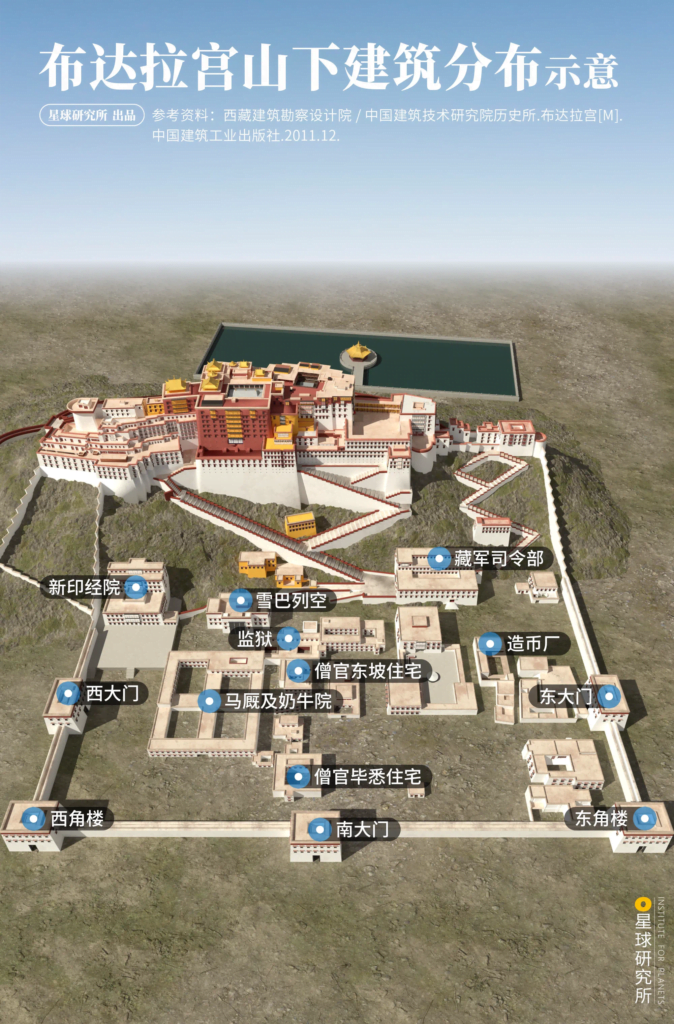
The Aesthetic Contrast of Potala Palace: White Palace and Red Palace
Potala Palace, an emblem of Tibetan heritage, showcases a striking architectural dichotomy between the White Palace and the Red Palace, each distinguished by their unique exterior colors and features. The White Palace walls are painted in a bright white, symbolizing peace and purity, while the Red Palace boasts a rich ocher-red, representing authority and power. The central part of the Red Palace features large vertical windows that span seven floors, creating a sharp contrast with the smaller windows of the White Palace and the narrow ventilation windows throughout the complex. This design choice not only highlights the central structure but also adds a dynamic visual element to the palace’s facade.
Architectural Harmony and Grandeur
The combination of robust stone walls and golden roofs creates a varied and majestic silhouette, with the play of light and shadow, solidity and space, and color contrasts emphasizing the central buildings. This thoughtful design achieves a high level of harmony and unity, making Potala Palace a masterpiece of architectural artistry.
Despite its enduring grandeur, the passage of time and lack of maintenance have left many parts of Potala Palace in a state of disrepair. The issues range from widespread decay, insect damage, and warping of wooden components to cracks in walls, sinking floors, and damage to the murals from smoke and pollution. Temporarily reinforced with wooden supports, the structure faces the risk of collapse due to overloaded foundations.
Potala Palace stands as a testament to the ingenuity and spiritual significance of Tibetan culture, yet it also reminds us of the ongoing need for preservation. Addressing the challenges of conservation is crucial to ensuring that this iconic monument continues to inspire and educate future generations about Tibet’s rich heritage.
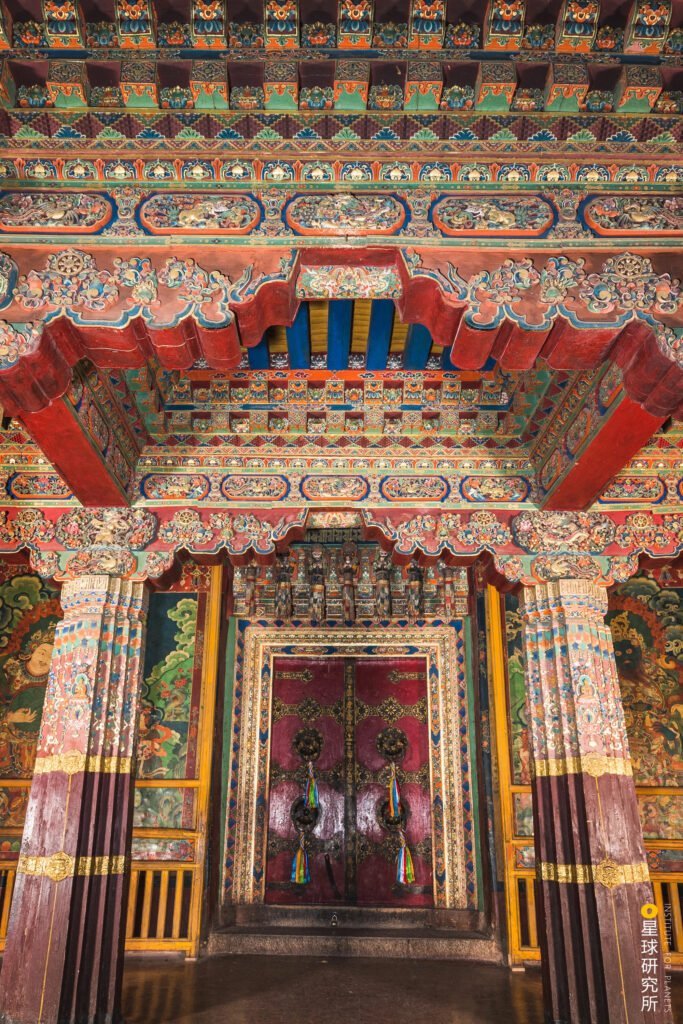
Revitalizing Potala Palace: A Testament to Cultural Preservation
The central government has placed significant importance on the preservation of Potala Palace, recognizing its monumental value in Tibetan culture and history. After extensive surveys and planning by Tibetan and Chinese experts, a comprehensive restoration project was launched, backed by a special fund of 40 million yuan along with contributions of gold and silver.
The restoration work officially began on October 11, 1989 (the first day of the eighth month in the Tibetan calendar), marking a pivotal moment in the conservation of this ancient architectural marvel. During a visit on July 24, 1990, then-President Jiang Zemin emphasized the importance of this endeavor with the inscription: “Maintain national unity, promote national culture.”
Increased Funding and Completion
As the restoration progressed, additional funds were allocated, bringing the total to 53 million yuan by the time the work was completed on August 10, 1994. The project covered an area of 34,000 square meters, and its completion was celebrated with the first Buddha exhibition since the liberation, reinvigorating a tradition of cultural and spiritual significance.
Today, Potala Palace stands not just as a fully restored piece of ancient architecture but as a vibrant center of Tibetan culture, attracting countless visitors from around the world each day. The successful restoration has not only preserved the physical structure but also contributed significantly to the promotion of Tibetan culture, ensuring that Potala Palace continues to be a symbol of heritage and unity for generations to come.

Potala Palace: A Treasure Trove of Tibetan Art and History
Potala Palace, beyond its architectural grandeur, is a vast repository of artifacts, making it an unparalleled art museum. The palace houses an array of precious items from the Ming and Qing dynasties, including imperial edicts, seals, gold and jade books, plaques, and gifts. Additionally, it boasts a rich collection of rare Tibetan manuscripts, gold and silver Buddha statues, ritual objects, thangkas, and murals. These treasures provide invaluable insights into Tibet’s political, economic, historical, cultural, and artistic heritage.
Sculptures Beyond Compare
- Diverse Buddhist Statues: Potala Palace is renowned for its collection of Buddhist statues, numbering between 200,000 to 300,000, making it the largest in Tibet. These sculptures include historical figures from the Tubo period, meticulously crafted Buddhas from various dynasties, ranging from the grand to the minute, each with unique and expressive forms. From the thousand-armed Avalokiteshvara to the serene Maitreya and majestic deities, the statues embody a spectrum of emotions and spiritual states.
- Iconic Figures: Noteworthy sculptures include a pure gold statue of Sakyamuni Buddha, adorned with a jeweled crown, and a silver statue of the Fifth Dalai Lama in monastic robes, exuding dignity and grace. The life-sized silver statue of Tsongkhapa, dressed in monastic attire and sitting in meditation, radiates kindness, while Padmasambhava’s silver statue, holding ritual objects, presents an imposing figure.
- Maitreya Buddha: A striking feature in the Maitreya Hall is a gilded copper statue of Maitreya Buddha, 3.66 meters tall, draped in divine garments and adorned with jewelry, exuding a gentle smile while sitting in meditation.
- Thousand-Armed Avalokiteshvara: This silver statue, standing 3 meters tall and made using 10,000 taels of silver, is a masterpiece of beauty and craftsmanship.
- Rare Finds: Among the rare treasures is a 51 cm tall alloy statue of Avalokiteshvara, a prized possession of the palace. Additionally, clay sculptures of Songtsen Gampo, Princess Wencheng, and Princess Chizun, believed to be original to the palace’s early construction, are extraordinarily precious.
Potala Palace’s art collection not only dazzles with its beauty and craftsmanship but also serves as a key to understanding the rich tapestry of Tibetan culture and Buddhism. Each piece tells a story, contributing to the palace’s status as a monumental center of history, spirituality, and art.
The Murals of Potala Palace: A Canvas of History and Spirituality
Potala Palace stands not just as an architectural marvel but also as a vibrant gallery of Tibetan art, thanks to the extensive murals adorning the walls of every hall and corridor. These murals, rich in color and detail, predominantly narrate Buddhist stories, reflecting the spiritual essence and historical depth of Tibetan culture.
White Palace Murals
- Origins and Completion: The murals in the White Palace began in May 1648, brought to life by 63 artists over a decade. They depict the origins of the Tibetan people, the history of Tibetan Buddhism, and the biographies of the first five Dalai Lamas.
- Historical Scenes: Notable among these is the depiction of palace architecture from the 7th century, Princess Wencheng’s journey into Tibet, and scenes of Tibetan minister Ludongzan seeking marriage for Songtsen Gampo with the Tang dynasty. The East Great Hall features the legend of “monkeys turning into men” and Princess Jincheng holding a precious mirror, illustrating the close ties between the Tang dynasty and Tibet.
Red Palace Murals
- Artists and Inspiration: Created in the late 17th century by 236 artists, the Red Palace murals were inspired by the Menri and Khyenri painting styles. The Sisipungtok Great Hall alone boasts 698 murals, chronicling the life of the Fifth Dalai Lama, including his notable audience with Emperor Shunzhi of the Qing dynasty in 1652. These murals vividly recount the Dalai Lama’s journey to Beijing, showcasing the grand reception and honors bestowed upon him by the emperor.
- Historical Depictions: Murals within the stupa hall dedicated to the Thirteenth Dalai Lama highlight his significant achievements and his audiences with Empress Dowager Cixi and Emperor Guangxu in 1908. On the second floor of the West Great Hall, murals depict the construction of the Red Palace, featuring artisans, overseers, and laborers, capturing the essence of the monumental effort behind its construction.
These exquisite murals of Potala Palace serve as a testament to the artistic genius and creativity of the Tibetan people. They not only embellish the palace with breathtaking visuals but also offer a profound insight into the historical events and spiritual narratives that have shaped Tibet. Through these vibrant artworks, visitors can glimpse the soul of Tibetan culture, preserved and celebrated within the walls of Potala Palace.
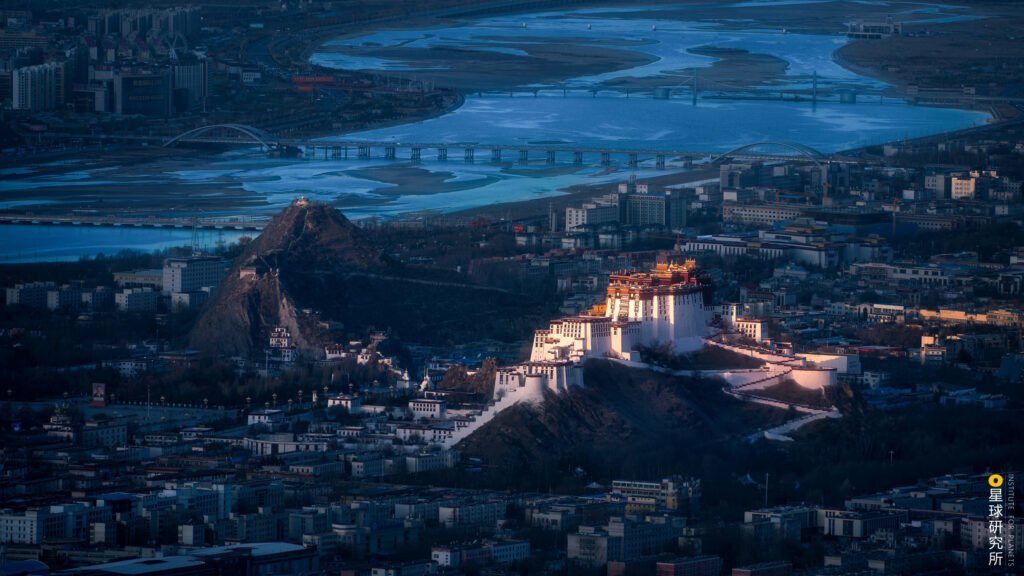
The Thangkas of Potala Palace: A Tapestry of Tibetan Lore
Potala Palace is not only an architectural masterpiece but also home to a significant collection of thangkas, traditional Tibetan Buddhist paintings on cloth. These thangkas are a fusion of art, religion, and history, making the palace a grand museum of Tibetan culture.
Iconic Thangkas of Potala Palace
- The Immense Amitayus Thangka: Among the most famous thangkas is the Amitayus Buddha Thangka, stretching 55.8 meters in length and 46.8 meters in width. Overseen by Depa Sangye Gyatso, this thangka was crafted by Tibetan master artist Tashi Tsering in 1996. It holds the Guinness World Record as the largest thangka in the world, showcasing the artistry and devotion of Tibetan Buddhism.

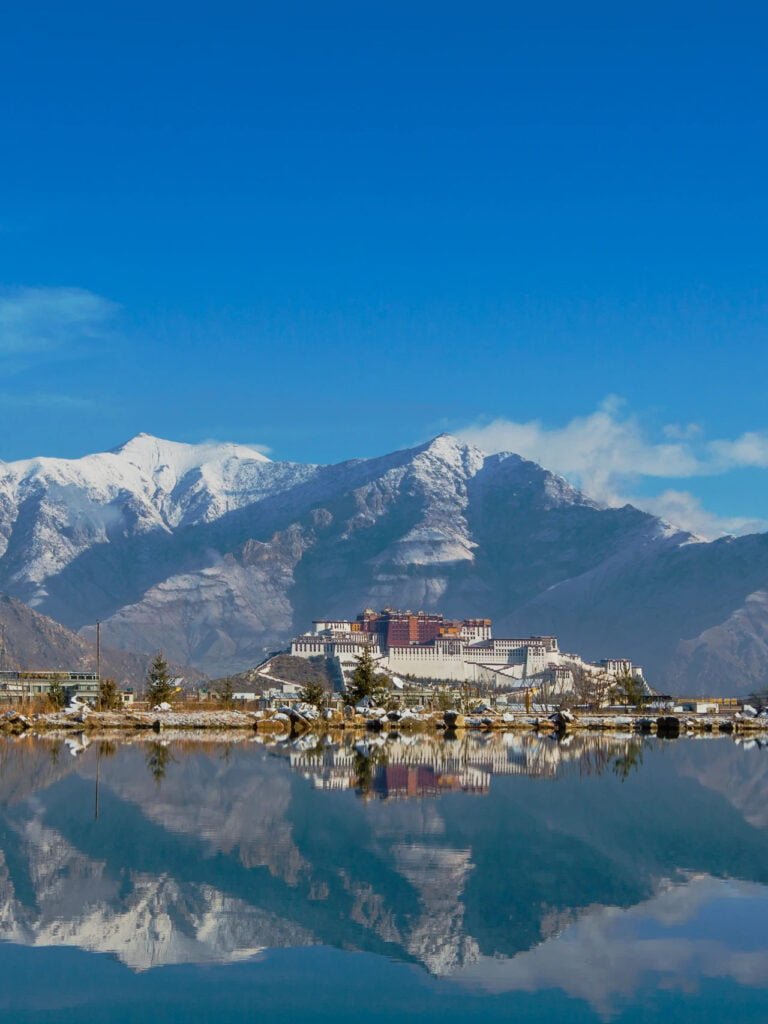
Popular Historical Thangkas in Potala Palace
Potala Palace treasures four thangkas from the Song and Yuan dynasties, including three from the Song dynasty that are particularly rare (two of which are silk tapestries).
- The Thangka of Padma Donyo Zhupa: This thangka features the inscription of its dedication to teacher Zhaba Jianzan by Jiangcun Zhading, a depiction of Zhaba Jianzan (1147–1216), the third of the “Five Founders” of the Sakya school of Tibetan Buddhism.
- The Thangka of Lama Zhang: Lama Zhang, the founder of the Tshalpa Kagyu lineage, is depicted in a lifelike silk tapestry, surrounded by 26 lamas and various animals. A treasure from the Song dynasty, it reflects the simplicity and authenticity of the era.
- The Biography Thangka of Milarepa: Milarepa, known for his legendary quest for enlightenment, is portrayed in meditation attire, teaching and meditating. The thangka vividly captures scenes from his life of asceticism, showcasing his journey towards spiritual achievement.
- The Thangka of Avalokiteshvara Net Eyes: This thangka depicts one of Avalokiteshvara’s 33 forms, seated in a playful posture, holding a lotus flower. It’s a gem from the Yuan dynasty, revered as a precious artifact.
A Window to Tibetan Spirituality
These thangkas not only serve as a visual feast but also as a medium through which the intricate tales of Buddhism, Tibetan history, and folklore are told. The thangkas of Potala Palace stand testament to the skillful craftsmanship and deep spiritual reverence of the Tibetan people, offering insights into the rich tapestry of their culture and beliefs. Visiting Potala Palace offers an opportunity to immerse oneself in the world of Tibetan thangkas, each painting a bridge to the divine and a reflection of the devoutness and creativity of a people dedicated to preserving their spiritual heritage.
The Legacy of the Dalai Lama: A Blend of Spirituality and Leadership
Potala Palace is not only a sanctuary for Tibetan Buddhist art but also houses historical treasures, including a portrait of Emperor Yongle of the Ming Dynasty. This portrait is not just a historical artifact but also a rare piece of art.
Portrait of Emperor Yongle
The thangka of Emperor Yongle, standing at 3.6 meters high and 1.87 meters wide, is exquisitely detailed. Emperor Yongle, dressed in a dragon robe and imperial crown, exudes authority from his throne adorned with jade and enamel, complete with dragon-headed armrests and decorations, a splendid example of artistic craftsmanship.

The Dalai Lama Reincarnation System
- Origin of the Name: “Dalai Lama” translates from Mongolian as “Ocean of Wisdom,” reflecting the vastness of the holder’s wisdom and compassion. The title was first bestowed by Altan Khan of the Tumed Mongols on Sonam Gyatso, recognizing his spiritual accomplishments.
- Historical Background: The lineage started with Gendun Drub, a disciple of Tsongkhapa, the founder of the Gelug school of Tibetan Buddhism, who established Tashilhunpo Monastery. His successors continued to play pivotal roles in the development of the Gelug tradition, with each recognized as an incarnation of Avalokiteshvara, embodying the compassion of this bodhisattva.
- Political and Spiritual Leadership: The role of the Dalai Lamas as both spiritual and political leaders of Tibet was solidified in 1642 when Güshi Khan, leader of the Khoshut Mongols, allied with the Gelug school and established the Fifth Dalai Lama, Lobsang Gyatso, as the ruler of Tibet. In 1653, the title of Dalai Lama was officially recognized by the Qing dynasty’s Emperor Shunzhi, further elevating its significance.
The Dalai Lama as a Symbol of Compassion
In Tibet, the Dalai Lama is revered as a living embodiment of Avalokiteshvara, known as “Gyalwa Rinpoche” (Precious Conqueror) in Tibetan, serving as the spiritual head of the Gelug school. This belief underscores the profound spiritual and political impact of the Dalai Lama lineage, establishing a unique intersection between governance and religious faith in Tibetan society.
The thangka of Emperor Yongle and the history of the Dalai Lama’s reincarnation system highlight the rich tapestry of Tibetan history, culture, and spirituality preserved within the walls of Potala Palace. These narratives not only tell the story of Tibetan Buddhism and its leaders but also reflect the deep connections between Tibet and its neighboring cultures, underscoring the importance of the Dalai Lama as both a spiritual guide and a historical figure.
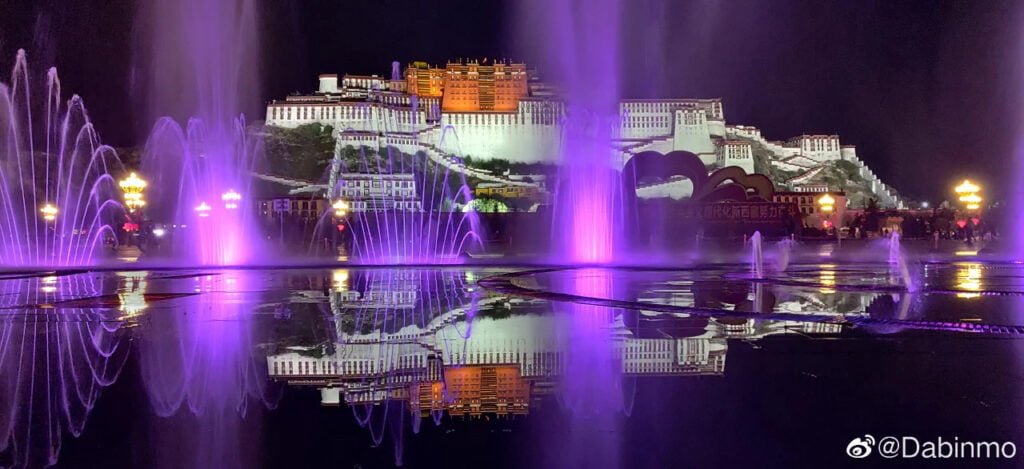
Visiting Potala Palace: Tips for a Memorable Experience
Potala Palace, with its rich history and stunning architecture, is a must-visit destination. Here are some essential tips to make your visit more enjoyable:
1. Navigating the Climb
For Those with Limited Mobility or Altitude Sickness: The climb to Potala Palace via the main entrance involves a strenuous ascent along a zigzagging stone staircase. Visitors who may find this challenging, such as the elderly or those experiencing altitude sickness, are advised to take a taxi to the rear of the palace. This route allows entry from the top, making it possible to explore from the top down, conserving energy.
2. Photography Regulations
Inside the Palace: Photography and videography are not permitted within the palace halls. If you wish to take photos or videos, be prepared to pay a fee as indicated by signs at the entrance. However, you’re free to take photos of the golden roofs, offering a unique glimpse into the architectural beauty of the palace.
Best Spots for Photography: For the perfect shot of Potala Palace, Yaowang Mountain Viewing Platform offers an excellent vantage point. The eastern side of the square near the water pool is ideal for capturing the palace’s night view. Dragon King Pond Park is great for morning and afternoon shots reflecting the palace, while the hillside to the right of the Lhasa River Bridge provides a stunning view of Potala Palace amidst the surrounding mountains.
3. Restroom Accessibility
Finding Restrooms: Restrooms in Potala Palace can be hard to locate, so it’s best to use them before starting your tour. The restrooms are situated to the north of Deyangsha within the White Palace, ingeniously built at the top of a cave that extends to the base of the mountain, humorously referred to as “the world’s deepest toilet.”
Following these tips can help ensure a smooth and enjoyable visit to Potala Palace, allowing you to fully appreciate its historical significance, architectural marvels, and breathtaking views.

